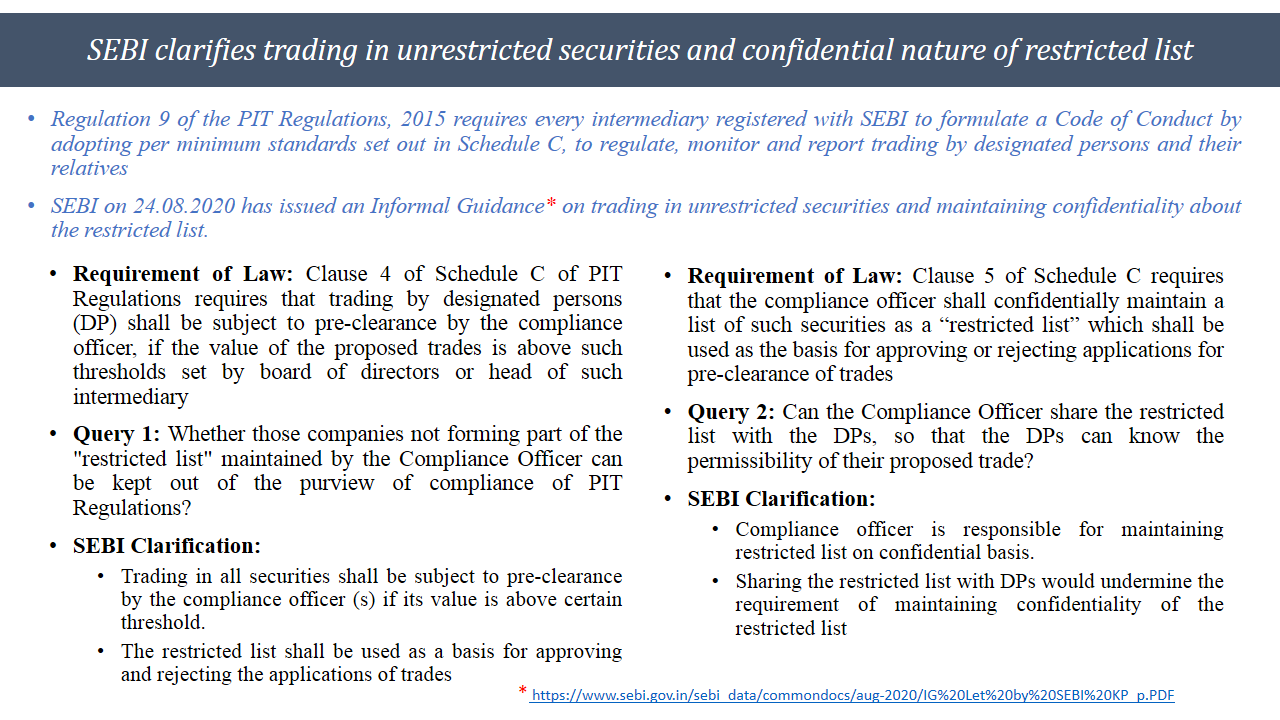SEBI’s informal guidance offers temporary escape from impossibility
– HVDLE guided to explain and not comply!
Anushka Vohra | Manager (corplaw@vinodkothari.com)
Introduction
Recently, SEBI rolled out stricter corporate governance (CG) norms for entities having its non-convertible debt security listed and having an outstanding value of Rs. 500 crore and above as on March 31, 2021 [referred as High Value Debt Listed Entities (HVLDEs)[1]]. One of CG norms applicable is to comply with the requirements that apply with respect to Related Party Transactions (RPTs). The approval requirement, stipulated for material RPTs mandates approval of shareholders and prohibits related parties to vote to approve the transaction. The intent of the law is to ensure approval by shareholders who are not related parties. As HVDLEs include private companies and closely held public companies that must have listed its debentures, this requirement resulted in an impossibility and deadlock. On being approached by one such entity, SEBI suggested a temporary carve out by advising ‘to explain’ and ‘not comply’.
On December 16, 2021, SEBI issued an informal guidance[2] under SEBI (Listing Obligations and Disclosure Requirements) Regulations, 2015 (Listing Regulations) relating to the applicability of CG requirements on HVLDEs.
Pursuant to the fifth amendment of the Listing Regulations, notified on September 07, 2021[3], the applicability of CG norms were extended to entities with non-convertible debt securities listed and the outstanding amount being Rs. 500 cr or more. While the provisions became applicable from September 07, 2021 the same was implemented on a ‘comply or explain’ basis until March 31, 2023. Accordingly, an HVDLE is expected to endeavour to comply with the provisions and achieve full compliance by March 31, 2023. In case the HVDLE is not able to achieve full compliance with the provisions, till such time, it shall explain the reasons for such non-compliance/ partial compliance and the steps initiated to achieve full compliance in the quarterly compliance report filed under clause (a), sub-regulation (2) of regulation 27 of these regulations.
RPTs by HVDLEs
An HVDLE, that were not equity listed, were only required to comply with Companies Act, 2013 (CA, 2013) requirements for the purpose of transacting with related parties. While CA, 2013 also provides for similar restrictions, it provides a carve out in case of closely held companies. The restriction of related parties not to vote in favor of a resolution, does not apply where ninety per cent. or more members, in number, are relatives of promoters or are related parties. However, there is no such carve out provided in Regulation 23 (4) of the Listing Regulations.
The present case
India Infradebt Limited (IIL), a joint venture company and an HVDLE, realised about this deadlock situation as all the shareholders, being venturers, were related parties in terms of Section 2 (76) of CA, 2013. Therefore, it approached SEBI seeking informal guidance for the procedure to be followed for obtaining shareholders’ approval in case of material RPTs.
SEBI provided a stop-gap solution and stated that in view of the ‘inherent difficulty’ by IIL in getting shareholders’ approval for material RPTs, it may choose to explain the reason for not complying.
Conclusion
A pertinent question that arises from the informal guidance and which has not been dealt with, is whether the HVLDEs that are closely held companies, be expected to be on the same pedestal as that of equity listed entities. Even if they are supposed to be, it cannot continue to explain for not complying as from April 1, 2023 these provisions will become mandatory and violation of the same will attract penalties from the stock exchanges.
Further, the RPT provision has been drastically amended and becomes effective from April 1, 2022[4]. The scope of related party and RPT has been widened and the threshold for material RPT has also been amended to impose a numerical threshold of Rs. 1000 crore along with the existing threshold of 10% of annual consolidated turnover. Additionally, the requirement to seek shareholder’s approval will be ‘prior’ to breaching the materiality thresholds.
Therefore, several HVDLEs may be required to seek shareholder’s approval for prospective transactions. SEBI should consider incorporating a carve out similar to that provided under CA, 2013 for closely held HVDLEs in Regulation 23 (4) of the Listing Regulations in order to resolve the issue permanently.
[1] Refer our write up at https://www.moneylife.in/article/bond-issuers-facing-disproportional-compliances-on-corporate-governance-as-sebi-move-nullifies-mca-exemption/65132.html
[2] https://www.sebi.gov.in/sebi_data/commondocs/dec-2021/SEBI%20Informal%20guidance%20letter%20to%20India%20Infradebt%20Limited%20-%20December%2016,%202021.pdf
[3] https://www.sebi.gov.in/legal/regulations/sep-2021/securities-and-exchange-board-of-india-listing-obligations-and-disclosure-requirements-fifth-amendment-regulations-2021_52488.html
[4] Refer our write up here:https://vinodkothari.com/article-corner-on-related-party-transactions/

